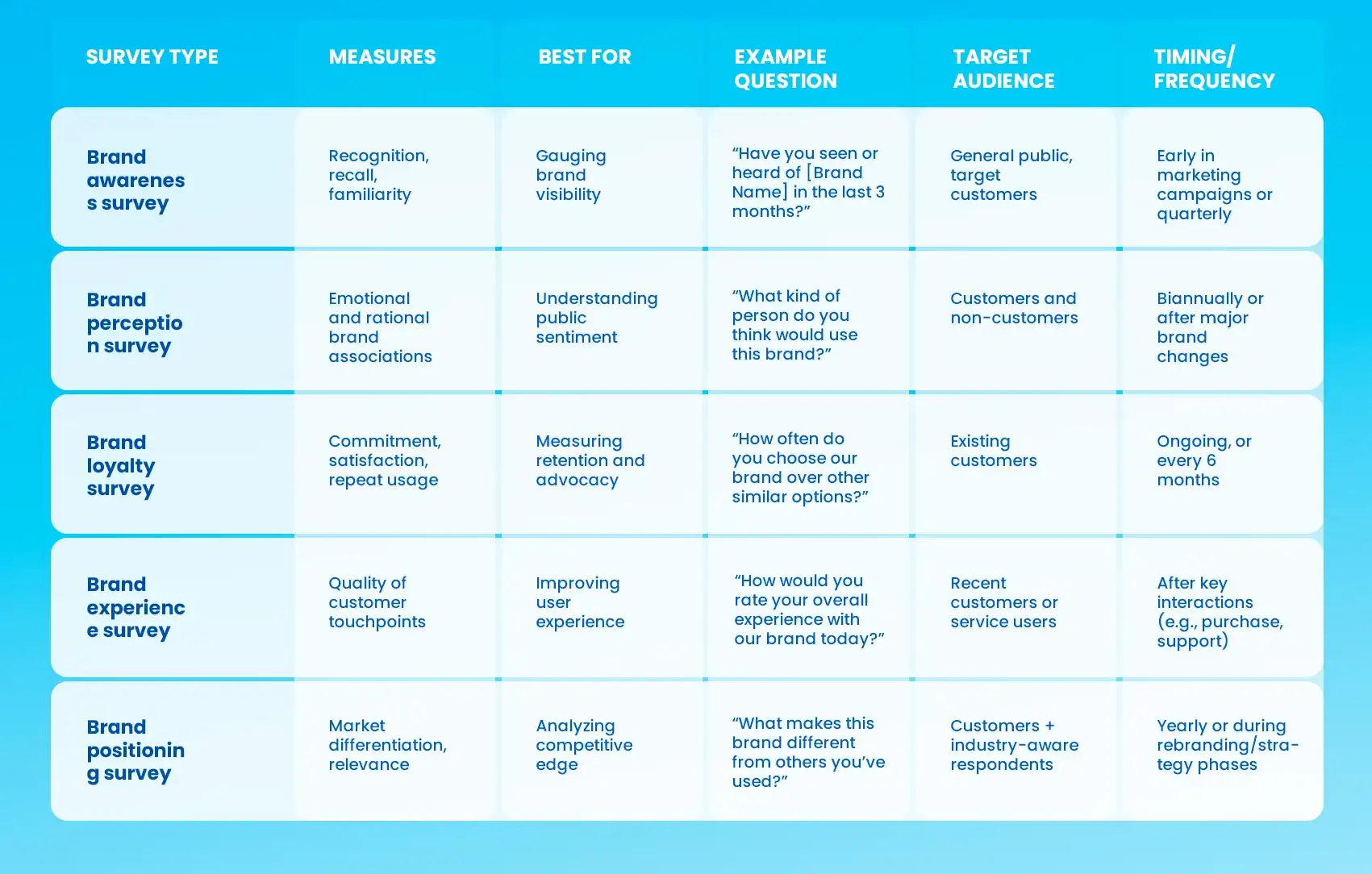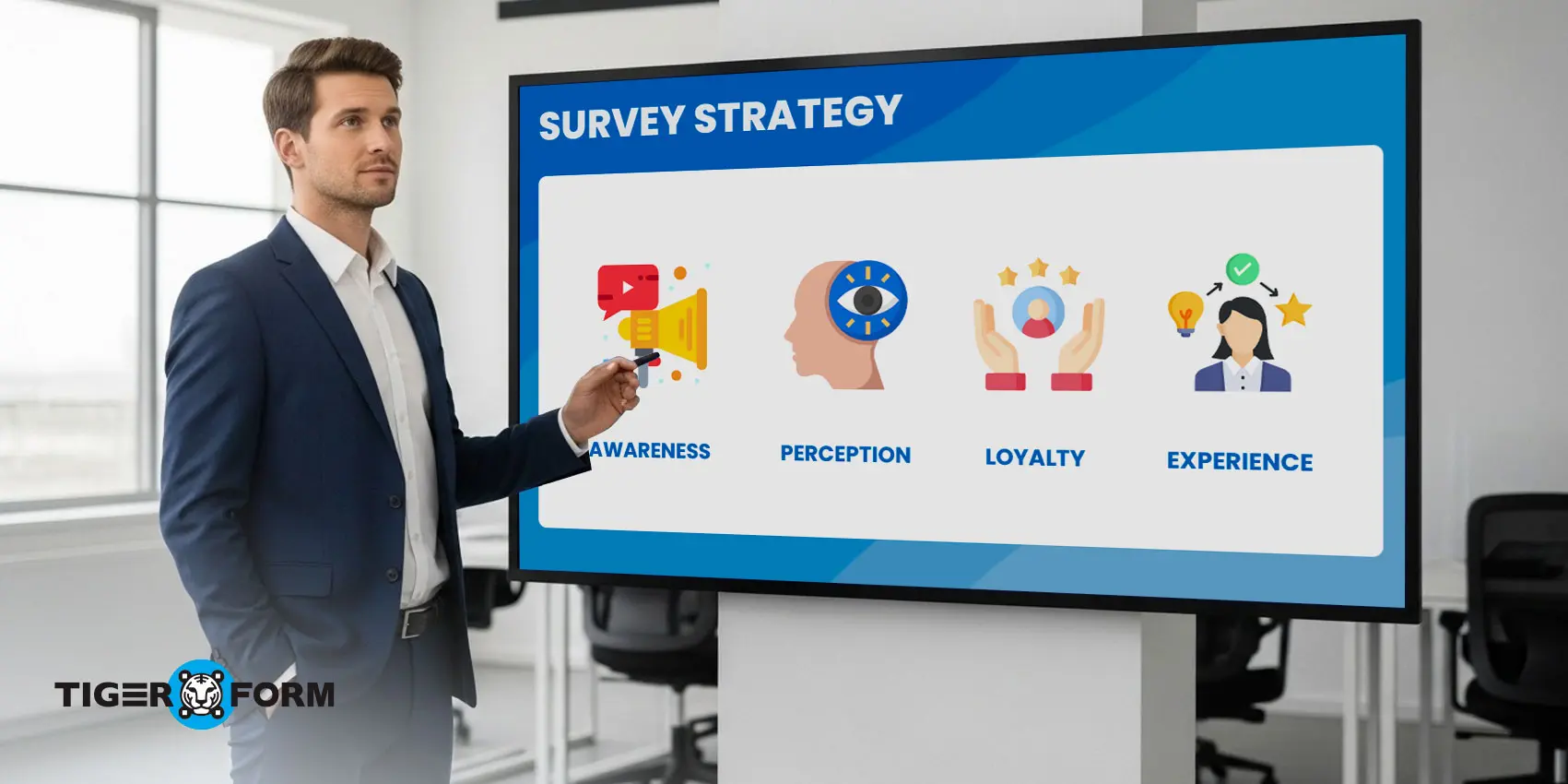
A brand survey is one of the simplest yet most underused tools for understanding how people view your business. Too often, companies spend months designing the perfect logo, writing catchy taglines, and launching polished campaigns only to discover that their audience didn’t connect with any of it.
Most brands depend on internal opinions or surface-level metrics to judge their performance. But without asking your actual audience, you’re just guessing. You might think your brand stands for innovation, but your customers might only see a product. You may believe you’ve built loyalty, but people could be ready to switch to the next better offer. This hurts growth, weakens trust, and wastes marketing efforts.
The right survey questions can reveal exactly how people perceive, remember, and connect with your brand. Once you know that, you can shape your messaging, visuals, and customer experience with clarity and purpose.
This article will help you understand the main types of survey questions with easy examples and how to create them with a form creator.
What is a brand survey, and why does it matter?
A brand survey is structured to collect meaningful feedback on how people perceive your brand. It helps you understand what your audience thinks, feels, and remembers when encountering your company name, logo, products, or communication. Instead of guessing how your brand is received, you get direct input from the people who matter most: your customers, leads, or even the general public.
These surveys can cover key areas like:
- Brand awareness – Do people recognize your brand?
- Reputation – How do they describe your brand to others?
- Trust – Do they feel confident choosing you?
- Messaging clarity – Do they understand what you stand for?
- Customer experience – Are their interactions smooth and consistent?
So why does this matter?
Because your brand doesn’t live in your logo or mission statement, it lives in the minds of your audience. You might think your branding is clear, engaging, and trustworthy, but you’re working off the wrong assumptions if your customers don’t experience it that way. That disconnect can quietly undermine your marketing, reduce customer loyalty, and leave your brand vulnerable to competitors.
A well-designed survey provides a reality check, helping you see your brand from the outside. With this insight, you can refine your brand positioning, sharpen your messaging, improve customer experience, and create marketing that resonates more deeply.
1. Brand awareness survey
A brand awareness survey helps you understand how well people recognize and recall your brand. It measures whether your target audience knows your brand exists, how familiar they are with it, and how easily they can identify it among competitors.
There are two key aspects to this:
- Aided awareness – When people recognize your brand from a list or visual cue (e.g., “Have you heard of Brand X?”).
- Unaided awareness – When people mention your brand without prompting (e.g., “Name a brand that makes athletic shoes”).
For example, a brand awareness survey for a new energy drink might ask:
“Which energy drink brands come to mind first?” or
“Have you seen any advertising for [Brand Name] in the past month?”
2. Brand perception survey
A brand perception survey helps you understand how your audience feels about your brand and what qualities they associate with it. While awareness tells you if people know your brand, perception tells you what they think about it.
This survey type explores rational and emotional impressions, such as whether people see your brand as trustworthy, innovative, affordable, or premium. It also reveals any disconnect between your intended brand identity and how it’s received.
Typical questions might include:
- “What words come to mind when you think of [Brand Name]?”
- “How would you describe [Brand Name] to a friend?”
- “Do you consider [Brand Name] a leader in its industry?”
Brand perception surveys give you the insights needed to shape reputation, fine-tune marketing, and build stronger emotional connections with your audience.
3. Brand loyalty survey
A brand loyalty survey measures how committed your customers are to your brand, how likely they are to stick with you, make repeat purchases, and recommend you to others. It helps you understand the strength of your customer relationships and what drives long-term retention.
This survey typically explores satisfaction, repeat behavior, and emotional attachment. One of the most common tools used is the Net Promoter Score (NPS), which asks:
“How likely are you to recommend [Brand Name] to a friend or colleague?”
Other sample questions might include:
- “How often do you choose [Brand Name] over competitors?”
- “What would make you stop using [Brand Name]?”
- “Do you feel a personal connection to [Brand Name]?”
4. Brand experience survey
A brand experience survey focuses on how customers feel about their interactions with your brand across various touchpoints, from visiting your website and using your product to contacting support or seeing your ads. It captures how smooth, consistent, and memorable those experiences are.
This survey goes beyond what people think about your brand; it asks how they’ve experienced it in real life. It helps uncover moments of delight, confusion, or frustration that shape a customer’s impression.
Likert scale questions are often used to measure experience more precisely. These allow respondents to rate their agreement or satisfaction on a scale (e.g., from “Strongly disagree” to “Strongly agree” or “Very dissatisfied” to “Very satisfied”).
Common questions might include:
- “How would you rate your recent interaction with our brand?”
- “Was it easy to find the information or product you were looking for?”
- “Did your experience match your expectations of the brand?”
5. Brand positioning survey
A brand positioning survey helps you understand how your brand is perceived in the market compared to your competitors. It reveals whether your audience understands what makes your brand unique and whether your messaging, values, and identity stand out correctly.
Positioning isn’t just about being seen; it’s about being remembered for the right things. This type of survey measures whether your brand has a distinct place in the customer’s mind and how well that perception aligns with your intended positioning.
What it measures:
- Differentiation: Is your brand seen as different or better than others?
- Relevance: Do customers see your brand as meeting their needs?
- Value proposition: Is it clear what you offer and why it matters?
- Competitive comparison: How do you stack up against others in your space?
Quick comparison table of surveys

How to choose the right survey type for your brand

Before you start asking your audience questions, it’s essential to know which questions will actually give you meaningful insights. There are different types of questions you can ask in a brand survey, some focus on recognition, others on perception, trust, or loyalty. But not every survey fits every situation. The key is choosing the type that matches what you’re trying to learn.
Here’s how to make sure you’re using the right approach:
1. Match your survey goals to the appropriate type
To determine whether people recognize your logo or remember your brand name, you’ll want to run a brand awareness survey. However, brand perception or positioning surveys are better if you care more about what customers think of your values, tone, or personality. Your specific business question should always guide the type of survey you choose.
2. Start small, then combine types for deeper insights
You don’t need to ask everything at once. In fact, shorter surveys often get better responses. Start with one clear objective, like understanding loyalty or tracking recall, and build from there. Later, you can combine different questions to get a fuller picture of how your brand performs across various dimensions.
3. Use surveys regularly to track trends over time
One survey can give you a snapshot, but regular surveys can show you a trend. Running surveys consistently (like quarterly or after major campaigns) helps you understand whether your brand is improving, staying flat, or heading in the wrong direction. This is especially helpful when tracking perception or emotional connection over time.
4. Segment your audience: loyal vs. new customers
Not all feedback should be treated the same. A longtime customer might love your brand for very different reasons than someone who just discovered you. Break your survey results down by customer type: new, returning, or inactive. This helps you build your brand by customizing messaging and customer experience more effectively for each group.
Steps to create a brand survey with a form generator
Running a brand survey is one of the most effective ways to understand how people see your business. However, the success of your survey depends heavily on how you build it. That’s why choosing a great form builder is significant.
A reliable form generator like TIGER FORM ensures your survey is easy to create and looks professional, works smoothly on any device, and delivers results in a clear, actionable format.
Step 1: Sign in to TIGER FORM
Start by logging into your Tiger Form account. If you don’t have one, you can quickly sign up for free. Once you’re in, head to your dashboard to begin creating your survey.
Step 2: Choose “Create New Form”
Click on “Create new form” to start building your survey. You can also choose from a ready-made form template for business needs.
Step 3: Add your survey title and description
Give your form a clear title, like “Brand Feedback Survey,” and include a short description explaining its purpose. Let your audience know their feedback is valuable and how it will be used.
Example: “Help us understand how you see our brand. Your honest feedback will help us improve our products, services, and message.”
Step 4: Add key survey questions
Now, add your questions based on what you want to learn. TIGER FORM supports multiple field types, such as short answers, multiple-choice questions, Likert scales, and drop-downs.
Step 5: Customize the design and settings
TIGER FORM lets you customize fonts, colors, and layout so your survey reflects your branding. You can also set logic rules, like showing certain questions only when a specific answer is chosen, which makes your survey more personalized.
Step 6: Set up notifications and a thank you message
Under form settings, you can:
Enable email notifications for every new response.
Add a custom thank-you message to show once the survey is submitted.
Example: “Thanks for sharing your thoughts! Your feedback helps us grow.”
Step 7: Generate a QR code for easy access
Before sharing, generate a QR code for your survey link. TIGER FORM allows you to create one directly from the publish settings. This is perfect for:
– Posters, flyers, or packaging
– In-store displays
– Live events or presentations
Simply download the QR code image and place it wherever your audience is likely to scan it.
Step 8: Publish and share your survey
Click “Publish” when you’re ready. TIGER FORM gives you multiple options to share:
– Direct survey link
– QR code
– Social sharing options
Choose what fits your audience best.
Step 9: Track responses and analyze results
Once your survey is live, check your Tiger Form dashboard for real-time results. You can:
View individual responses
See charts and graphs
Export data to Excel or Google Sheets for deeper analysis
This helps you spot trends, track progress, and make informed brand decisions.
Tips for writing great survey questions for brands
The quality of your survey questions directly affects the quality of insights you’ll receive. Poorly written questions can confuse respondents, introduce bias, or lead to inaccurate results. Here are some essential tips to ensure your survey delivers clear, honest, and useful feedback:
1. Keep language neutral and unbiased
Avoid using emotionally charged or persuasive language that might influence responses. For example, instead of asking, “How much do you love our eco-friendly packaging?”, ask, “How would you rate the sustainability of our packaging?” This helps you get honest, balanced feedback.
2. Avoid leading or confusing wording
Clarity is key. Questions should be direct and easy to understand. Avoid double negatives or combining two questions in one (e.g., “How satisfied are you with our product and service?” This should be split into two).
3. Mix yes/no, multiple-choice, and open-ended questions
Using a variety of question types keeps the survey engaging and helps you gather quantitative data (like percentages or ratings) and qualitative insights (like specific suggestions or sentiments). For example:
- Yes/No: “Have you heard of our brand before?”
- Multiple choice: “Which words best describe our brand?”
Open-ended: “What do you wish we did better?”
4. Limit to 10–15 questions to reduce survey fatigue
Keep your survey focused. Respondents are more likely to complete a survey that’s quick and purposeful. Try to ask only what’s truly important to your brand goals and save additional questions for future follow-ups.
5. Test the survey internally before launching
Run the survey with team members or a small test group first. This helps catch any confusing questions, technical glitches, or logic errors. A quick internal test can improve response quality and prevent issues once the survey goes live.
Take the guesswork out of branding—start your free survey today
An effective brand survey helps you move beyond assumptions and get real answers about how people see your brand. Are they aware of it? Do they trust it? Do they feel connected to it or could they easily switch to a competitor?
Without this kind of feedback, you’re making decisions in the dark. You might be pouring time and money into messaging that doesn’t stick or building loyalty programs for customers who don’t feel loyal.
A well-designed survey gives you the clarity to fix what’s broken, double down on what’s working, and truly align your brand with your audience’s expectations. Whether you’re testing brand awareness, perception, loyalty, or positioning, the right insights can sharpen your strategy and set your brand apart.
With TIGER FORM, building a survey is fast, easy, and free.
If you’re serious about growing a brand people recognize, trust, and choose, don’t wait.
Launch your survey today and build a brand that truly connects.
FAQs
1. How often should I run a survey for brand?
It’s best to run the survey quarterly or after major campaigns. Regular check-ins help you track changes in perception, satisfaction, and awareness over time, so you can adjust your strategy accordingly.
2. What types of questions should I include in a survey for a brand?
A good brand survey includes a mix of question types, such as multiple choice, Likert scale, yes/no, and open-ended questions. These help you measure brand awareness, perception, loyalty, experience, and overall customer satisfaction from different angles.
3. Who should I send my brand survey to?
You should send your survey to a mix of current customers, potential customers, and even people who chose competitors. This gives you a well-rounded view of how your brand is perceived across different groups. For the most accurate insights, make sure your sample matches your target audience.
